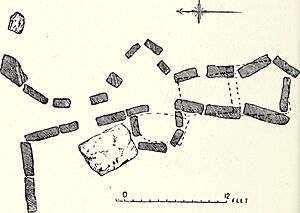Duntryleague passage tomb facts for kids
Quick facts for kids Duntryleague passage tomb |
|
|---|---|
| Native name Irish: Tuama Pasáiste Dhún Trí Liag |
|
 |
|
| Type | passage grave |
| Location | Deerpark, Duntryleague, County Limerick, Ireland |
| Elevation | 262 m (860 ft) |
| Built | c. 3500 BC |
| Official name: Duntryleague passage tomb | |
| Reference no. | 315 |
| Lua error in Module:Location_map at line 420: attempt to index field 'wikibase' (a nil value). | |
Duntryleague passage tomb is an ancient burial site in Ireland. It's also known as "Dermot & Grania's Bed." This special tomb is found on top of Duntryleague Hill in County Limerick. It is a protected National Monument.
Contents
Where is Duntryleague Passage Tomb?
This ancient tomb sits on Duntryleague Hill. This hill is about 1.9 kilometers (1.2 miles) northwest of Galbally, a town in County Limerick. From the hill, you can see the beautiful River Loobagh valley.
When Was It Built?
The Duntryleague passage tomb is very old. It was built around 3500 BC. That means it's about 5,500 years old!
Legends of the Tomb
According to old Irish stories, this tomb was the burial place of a king. His name was Ailill Aulom, also known as Oilill Olum. He was a King of Munster.
What Does the Tomb Look Like?
A "passage tomb" is a type of ancient grave. It has a long passage leading to a burial chamber. The Duntryleague tomb is missing its outer stone mound, called a cairn. But many of its large capstones are still in place. These are the big stones that form the roof of the tomb.
How is it Built?
The tomb is built facing north to south. Its style is similar to other ancient tombs found in Brittany, a region in France. This suggests that people in ancient times might have shared building ideas across different lands.


